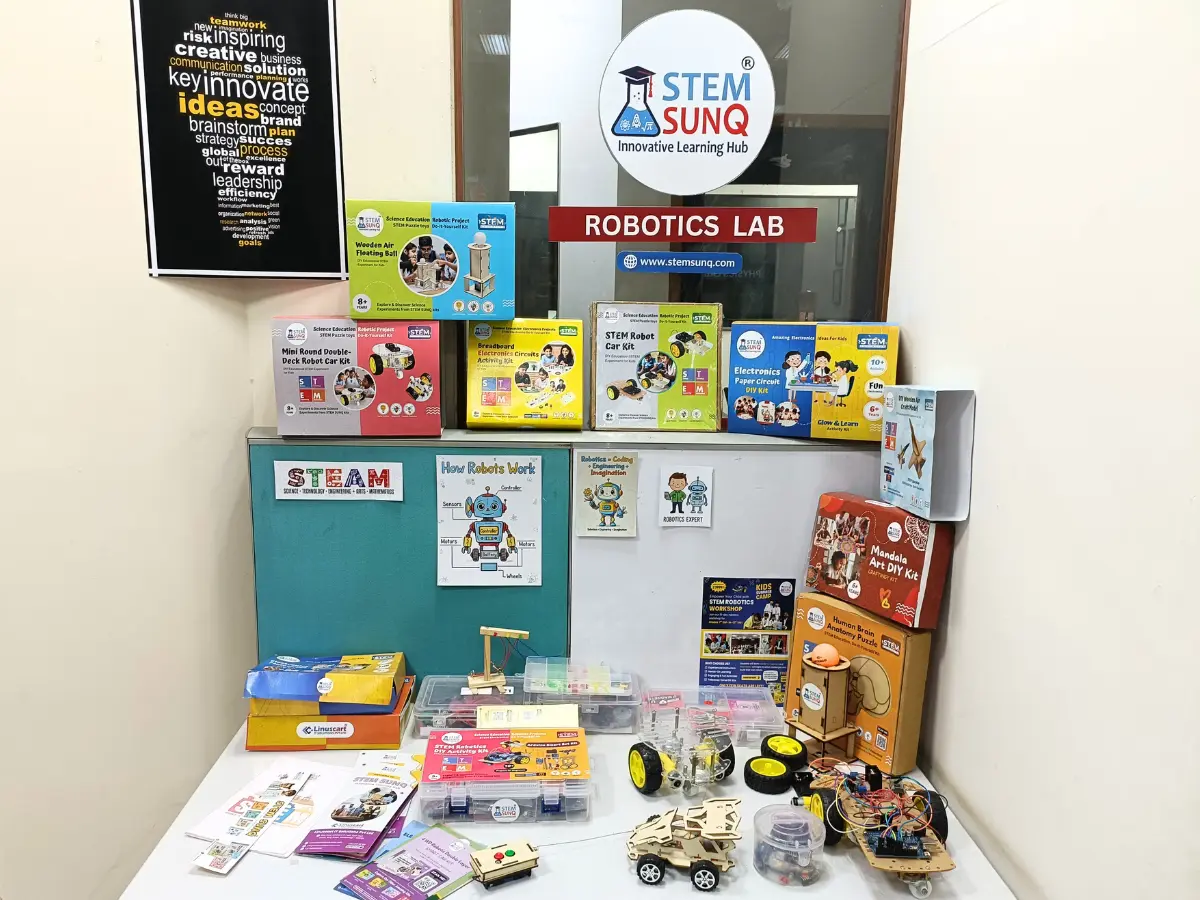
ATL - Atal Tinkering Lab for Schools
What if learning science could be as fun as it is informative?
The Atal Tinkering Lab (ATL) gives students the chance to roll up their sleeves and get hands-on with science and technology at school.
Instead of just reading about science, students get to experiment, build things, and figure out how stuff actually works.
Many schools want to set up an ATL, but they often don’t know where to start, what they’ll need, or how much it will cost, and they’re unsure about what really happens inside the lab.
Understanding the Atal Tinkering Lab Initiative
A big step taken by the Indian government to start Atal Tinkering Lab to make learning science and technology more practical, creative and engaging for students.
Instead of just focusing on theories, children get a chance to explore technology, build projects, try out ideas, and really understand how things work when it comes to applying theory knowledge.
ATL’s goal is to create a generation of thinkers, problem solvers, and young innovators who can shape the future with their creative ideas.

1. What is an Atal Tinkering Lab?
An Atal Tinkering Lab (ATL) is a dedicated innovation space set up in schools for students from Class 6 to 12.
The lab is filled with tools related to electronics, robotics, sensors, 3D printing, mechanical tools, DIY kits, and basic science lab and math lab equipments.
Students use these tools to create small projects, understand real world problems, and come up with solutions through hands-on learning.
It’s a place where they can experiment freely without the fear of making mistakes because every mistake is the first step of learning something new.
2. Who Invented the Atal Tinkering Lab Concept?
The idea of Atal Tinkering Labs was introduced by the Atal Innovation Mission (AIM) under NITI Aayog, Government of India.
AIM was created to promote a culture of innovation, entrepreneurship, and problem solving among young Indian students.
With ATL, AIM wanted to bring modern technology and practical learning directly into classrooms so that every child gets the chance to think creatively and learn beyond textbooks.
3. Vision and Mission Behind ATLs
The vision of Atal Tinkering Labs is clear, which is to build a generation of young innovators who can think independently, understand technology, and create meaningful solutions for everyday challenges. The mission is to:
- Encourage curiosity, creativity, and imagination in students
- Help children develop design thinking and problem-solving skills
- Provide access to modern tools like robotics, 3D printing, sensors, and DIY kits
- Build confidence by allowing students to experiment, make mistakes, and improve
- Prepare students for future careers in science, technology, engineering, and innovation
In simple words, ATLs goal to take students from “learning to know” to “learning to do”
The Purpose and Benefits of Atal Tinkering Lab
1. Cultivating Innovation and Problem-Solving Skills
One of the biggest purposes of ATL is to help students think creatively and solve problems by themselves.
When students work on hands-on practical projects, whether it’s a small robot, a DIY circuit, or a simple model, they learn how to identify problems, test different solutions, and improve their ideas.
This kind of thinking stays with them for life and helps them in every field, not just science.
2. Promoting STEM Education in Schools
ATLs play a major role in making STEM (Science, Technology, Engineering, Mathematics) learning more interesting.
The tools, equipment and kits in the lab help students to understand concepts like robotics, coding, electronics, mechanics, and design through real practical activities.
This practical exposure helps schools build a strong STEM culture, turning it into an experience that’s hands-on, engaging, and fun for students.
3. Long-term Educational Advantages for Students
ATLs do more than just support students in the classroom, they help get them ready for the future.
The experiences students gain in these labs build important skills that support their overall growth and open new opportunities.
A. Skill Development Outcomes
Here are some of the important skills students naturally develop while working in ATLs:
- Creative Thinking: Students learn how to think differently and come up with new ideas.
- Teamwork & Collaboration: Working on group projects helps them communicate and cooperate better.
- Logical & Analytical Skills: Hands-on activities improve their ability to think clearly and solve problems step-by-step.
B. Career Preparation Benefits
ATLs also help students build early interest in career paths linked to science, technology, and innovation. Some key benefits include:
- Early Exposure to Technology: Students become familiar with tools like robotics, sensors, and 3D printers, which are used in modern careers.
- Confidence in Practical Skills: They learn how to turn ideas into actual models, which builds confidence in taking up technical fields later.
- Better Understanding of Future Opportunities: ATL activities open doors to fields like engineering, product design, coding, AI, and more.
Current Status of ATLs Across India
The Atal Innovation Mission (AIM) has made impressive progress over the years in rolling out Atal Tinkering Labs (ATLs) in schools across India. As a result, thousands of students now have access to hands-on STEM learning, practical tools, and opportunities to innovate.
1. Number of ATLs in India
- As of recent official information, there are about 10,000 ATLs established in schools across India.
- According to AIM’s data, these labs engage over 1.1 crore students nationwide.
The resources are collected from AIM.
2. Geographic Distribution
- ATLs are spread across all States and Union Territories of India, covering 700+ districts.
- This broad distribution ensures that both urban and rural schools — government, government-aided, and private — get access to ATL facilities, making innovation more inclusive.
3. Success Stories & Impact
- ATLs have helped thousands of students explore STEM fields through practical projects, turning classroom lessons into real-world experiences in a fun and creative way.
- Their widespread presence has created a nationwide ecosystem of young innovators who are comfortable using modern tools like robotics kits, electronics, 3D printing, IoT components, etc.
Setting Up an Atal Tinkering Lab: Process and Requirements
Setting up an Atal Tinkering Lab is an organized process guided by the Atal Innovation Mission (AIM). Schools need to meet certain eligibility criteria, apply through the official portal, and go through a selection process. Once selected, they receive financial support, guidelines, and resources to build the lab. Here’s a simple breakdown of how it works.
1. Eligibility Criteria for Schools
Schools must follow a few basic requirements to qualify for an ATL. AIM wants to ensure that the schools selected can create a proper environment for hands-on learning and innovation.
Key eligibility criteria include:
- The school must be a Government, Government-aided, or Private school with classes from 6 to 12.
- Basic infrastructure such as electricity, internet, and a dedicated room for the ATL should be available.
- The school should show interest in promoting STEM and innovation activities among students.
A committed ATL in-charge and teacher support must be assured.
2. How to Apply for an Atal Tinkering Lab
Applying for an ATL is done online through the Atal Innovation Mission’s official application portal.
Schools must fill out the application form with correct details regarding infrastructure, student strength, academic activities, and STEM initiatives.
They also need to upload necessary documents such as school registration information, photographs, and details of the proposed ATL space.
Once the application is submitted, AIM reviews it based on utility, willingness, and school involvement.
3. Selection Process and Key Considerations
After applications are submitted, AIM analyzes them carefully. The selection is based on a combination of infrastructure, motivation, school environment, and willingness to support innovative learning.
Schools that show a strong commitment to hands-on STEM education have higher chances of being selected.
Why Schools Should Be Selected for ATL
Here’s what AIM looks for while selecting schools:
- Encouragement for Innovation: Schools that show active interest in promoting creativity and STEM activities.
- Supportive Environment: A school culture where teachers and students are open to experimenting and learning by doing.
- Community Impact: The capability of the school to inspire not just its students but the larger community around it.
Financial Aspects and Equipment for ATLs
Setting up an Atal Tinkering Lab requires understanding the funding support, budget planning, and the type of tools included in the lab. AIM provides financial assistance to selected schools so they can set up the space and run activities smoothly.
1. Funding for Atal Tinkering Labs
Selected schools receive ₹20 lakhs in total ATL funding from the Atal Innovation Mission (AIM):
- ₹10 lakhs (one-time grant) for purchasing equipment, tools, and setting up the lab.
- ₹10 lakhs distributed over 5 years for maintenance, operational costs, and consumables.
This funding helps schools create a complete hands-on STEM learning space without financial burden.
2. ATL Lab Setup Costs and Budget Allocation
| Category | Estimated Allocation |
| Equipment & DIY Kits | ₹6,00,000 – ₹7,00,000 |
| Furniture & Basic Setup | ₹1,00,000 – ₹1,50,000 |
| Safety Tools & Storage | ₹50,000 – ₹1,00,000 |
| Laptops, Internet, Software | ₹1,00,000 – ₹1,20,000 |
| Training & Workshops | ₹50,000 – ₹80,000 |
3. Budget Projections for ATL in 2025
Schools setting up an ATL in 2025 can expect similar allocation patterns, with a focus on modern tools like robotics kits, sensors, 3D printing, and electronics.
Equipment Included in an ATL Lab:
An ATL typically includes a wide range of tools that support hands-on science, electronics, mechanics, and technology learning. These tools help students build real working models and prototypes.
Essential Tools and Technologies:
- Robotics kits and electronic components
- Sensors, microcontrollers, and coding tools
- 3D printer and materials
- Hand tools and mechanical tools
- DIY STEM kits and project-making materials
- Safety gear and basic lab instruments
Frequently Asked Questions (FAQ)
Government, government-aided, and private schools with classes 6 to 12 are eligible. The school must have basic infrastructure like electricity, internet, and a dedicated room for the ATL, along with a willingness to promote STEM and innovation among students.
A school should be selected for ATL if it actively promotes creativity, hands-on learning, and STEM activities. Schools that show strong student interest, committed teachers, and a supportive environment for innovation are ideal candidates. ATL helps such schools nurture young problem-solvers and future-ready learners.
Setting up an ATL typically costs ₹10 lakhs, which covers equipment, tools, furniture, safety materials, laptops, and other essentials. Additional operational and maintenance expenses are supported by the ₹10 lakh operational grant provided over five years.
Thinking of Setting Up an Atal Tinkering Lab for Your School?
At STEM SUNQ, we help schools build complete ATL spaces with the right equipment, training, and support. If you want a smooth setup and a lab that truly adds value to your students, we’d love to assist you.
We make the entire process simple and smooth so your school can focus on what truly matters: helping students learn by doing.
👉 Get in touch with us today to set up your ATL the right way and inspire the next generation of young innovators.


